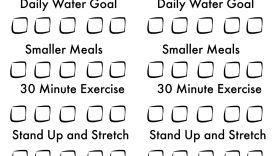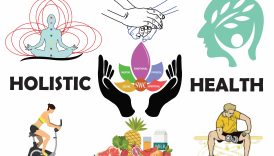7 Steps to Embracing a Healthier Lifestyle from Now On

Why Adopt a Healthier Lifestyle?
In today’s fast-paced world, the importance of adopting a healthier lifestyle cannot be overstated. Many people often find themselves caught up in their daily routines, neglecting physical well-being in favor of convenience. Embracing health-focused habits is essential not just for physical fitness, but for overall quality of life. Consider this: when Sarah, a busy marketing executive, shifted her focus to a healthier lifestyle, she noticed profound changes in her energy levels and mood. The transformation started small, with simple dietary tweaks and incorporating exercise into her day. The result? Enhanced productivity at work and a renewed sense of happiness. So, why make the shift? Here are some compelling reasons:
- 7 Steps to Embracing a Healthier Lifestyle from Now On
- Why Adopt a Healthier Lifestyle?
- Step 1: Setting Realistic Goals
- Short-term vs. Long-term Goals
- Step 2: Eating a Balanced Diet
- Importance of Nutrient-rich Foods
- Step 3: Regular Exercise Routine
- Types of Physical Activities
- Step 4: Prioritizing Sleep
- Tips for Better Sleep Hygiene
- Step 5: Managing Stress Levels
- Mindfulness and Relaxation Techniques
- Step 6: Hydration and Its Impact
- Benefits of Drinking Enough Water
- Step 7: Regular Health Check-ups
- Importance of Preventive Healthcare
- Boosted Energy: A balanced diet and regular exercise can significantly elevate energy levels.
- Improved Mental Health: Physical activity releases endorphins, helping to alleviate stress and anxiety.
- Longer Life: Healthy lifestyle choices can reduce the risk of chronic diseases, enhancing longevity.
By prioritizing health, individuals can enjoy a more vibrant and fulfilling life, just like Sarah. The journey to a healthier lifestyle begins with the right mindset and actionable steps.
Step 1: Setting Realistic Goals
Short-term vs. Long-term Goals
As individuals embark on their journey to a healthier lifestyle, the first step is to set realistic and achievable goals. This process lays the foundation for lasting change. Understanding the distinction between short-term and long-term goals is essential for maintaining motivation and progress. Short-term Goals are immediate and can be accomplished within days or weeks. For example, instead of aiming to lose 20 pounds right away, one might set a goal to include at least one serving of vegetables in every meal for the week. This approach creates quick wins that boost confidence. Long-term Goals, on the other hand, span months or even years. These include broader objectives such as reaching a healthy weight or maintaining regular exercise habits. For instance, a long-term goal could be to run a 5K in six months. A balanced approach might look like this:
- Short-term Goals:
- Drink eight glasses of water daily for one month.
- Exercise three times a week for the next four weeks.
- Long-term Goals:
- Achieve a healthy BMI over the next year.
- Cultivate a consistent yoga practice for stress management.
Setting both types of goals allows for progress monitoring while keeping the end vision in mind. This method not only fuels motivation but also fosters a sense of accomplishment along the health journey.
Step 2: Eating a Balanced Diet
Importance of Nutrient-rich Foods
Following the process of setting realistic goals, the next crucial step in adopting a healthier lifestyle is focusing on a balanced diet rich in nutrients. Eating the right foods not only supports physical health but also enhances mental well-being. Take John, who, after adopting a nutrient-rich diet, experienced increased vitality and improved mood. He incorporated a variety of colorful fruits and vegetables, whole grains, lean proteins, and healthy fats into his meals. This simple change made a world of difference in his life. So, why are nutrient-rich foods essential? Here are a few compelling reasons:
- Fuel for Energy: Nutrient-dense foods provide the energy necessary for daily activities and workouts.
- Disease Prevention: A diet high in vitamins, minerals, and antioxidants can reduce the risk of chronic illnesses.
- Weight Management: Whole foods typically have fewer calories compared to processed alternatives, aiding in weight control.
Here’s a breakdown of nutrient-dense foods you might include in your diet:
- Fruits: Berries, apples, and oranges
- Vegetables: Spinach, broccoli, and bell peppers
- Whole Grains: Quinoa, brown rice, and oats
- Proteins: Chicken, fish, beans, and nuts
Incorporating these foods can profoundly influence one’s overall health journey, transforming it into a positive and rewarding experience.
Step 3: Regular Exercise Routine
Types of Physical Activities
After focusing on a balanced diet, it’s essential to integrate a regular exercise routine into your lifestyle. Physical activity is a cornerstone of health that not only enhances physical fitness but also boosts mood and overall well-being. For Lisa, a marketing professional juggling her career and family, finding time to exercise felt daunting. However, she discovered various types of physical activities that could fit into her busy schedule, transforming exercise into a joyful part of her day. Here are some effective categories of physical activities:
- Cardiovascular Exercises: Activities like jogging, cycling, or swimming that raise your heart rate and build endurance. Aim for at least 150 minutes of moderate aerobic activity weekly.
- Strength Training: Incorporating weight lifting or bodyweight exercises (like push-ups and squats) twice a week builds muscle and enhances metabolism.
- Flexibility and Balance: Practices such as yoga or Pilates improve flexibility and stability, reducing injury risks. These can be refreshing breaks during a hectic week.
- Recreational Activities: Engaging in sports, hiking with friends, or dancing not only provides exercise but also adds fun to the routine.
By exploring different types of physical activities, everyone can find something enjoyable that fits their lifestyle, making the journey to fitness sustainable and fulfilling.
Step 4: Prioritizing Sleep
Tips for Better Sleep Hygiene
Following the incorporation of a regular exercise routine, it’s crucial to recognize the significance of sleep in achieving a healthier lifestyle. Quality sleep serves as a foundation for physical recovery, mental clarity, and emotional balance. Take Mark, a graphic designer who once struggled with sleepless nights due to work stress. By prioritizing his sleep hygiene, he transformed his sleep quality and, subsequently, his overall health. To help others on a similar journey, here are some practical tips for better sleep hygiene:
- Establish a Sleep Schedule: Go to bed and wake up at the same time every day to regulate your body’s internal clock.
- Create a Relaxing Bedtime Routine: Engage in calming activities, like reading or taking a warm bath, to signal your body that it’s time to wind down.
- Limit Screen Time: Reduce exposure to screens at least an hour before bed, as the blue light emitted can disrupt melatonin production.
- Optimize Your Sleep Environment: Ensure your bedroom is cool, dark, and quiet. Comfortable bedding can also enhance your sleeping experience.
- Mind Your Diet: Avoid heavy meals, caffeine, and alcohol close to bedtime, as these can disrupt sleep patterns.
By implementing these strategies, individuals like Mark can unlock the health benefits of restful nights, paving the way for greater vitality and well-being.
Step 5: Managing Stress Levels
Mindfulness and Relaxation Techniques
As individuals focus on prioritizing sleep, it becomes increasingly important to address stress management as well. Stress can hinder progress towards a healthier lifestyle, impacting both physical and mental health. Finding effective ways to manage stress is key to achieving overall well-being. Consider Emma, a busy nurse who frequently felt overwhelmed by her demanding job. After discovering mindfulness and relaxation techniques, she was able to reclaim her peace of mind. Here are some methods that can help anyone reduce stress:
- Mindfulness Meditation: Taking just a few minutes each day to practice mindfulness can enhance emotional resilience. This involves focusing on the present moment, observing thoughts without judgment.
- Deep Breathing Exercises: Simple deep breathing techniques, such as inhaling for four counts, holding for four, and exhaling for four, can quickly calm the mind and body.
- Progressive Muscle Relaxation: This involves tensing and then relaxing each muscle group systematically, alleviating physical tension.
- Nature Walks: Spending time outdoors can uplift spirits and lower stress levels. Emma often found solace in walks through her local park.
By embracing these mindfulness and relaxation techniques, individuals can effectively manage stress, fostering a more balanced and fulfilling health journey.
Step 6: Hydration and Its Impact
Benefits of Drinking Enough Water
Continuing the journey to a healthier lifestyle, another critical aspect to focus on is hydration. While managing stress and prioritizing sleep are essential, staying adequately hydrated can have profound effects on overall health and well-being. Take Mike, a tech engineer who often felt sluggish during the day. After consciously increasing his water intake, he experienced elevated energy levels and improved focus. So, why is staying hydrated so vital? Here are some notable benefits of drinking enough water:
- Enhances Physical Performance: Proper hydration can boost endurance, strength, and overall athletic performance, making workouts more effective.
- Aids Digestion: Drinking water helps in the digestion process and prevents constipation, ensuring a healthy gut.
- Promotes Healthy Skin: Adequate hydration can improve skin elasticity and contribute to a glowing complexion.
- Regulates Body Temperature: Water helps to maintain body temperature, essential during physical activities and hot weather.
Hydration Tips:
- Aim for at least 8 glasses of water daily, adjusting based on activity levels.
- Carry a reusable water bottle to encourage regular drinking throughout the day.
- Infuse water with fruits or herbs for added flavor and excitement.
By prioritizing hydration, individuals can experience these numerous benefits, fueling a more vibrant and energized health journey.
Step 7: Regular Health Check-ups
Importance of Preventive Healthcare
As one embraces a healthier lifestyle through hydration and stress management, the final step to consider is the significance of regular health check-ups. Preventive healthcare plays a pivotal role in maintaining overall well-being and catching potential issues before they escalate. For Anna, a 35-year-old teacher, scheduling annual check-ups became a game-changer. After a routine screening uncovered high cholesterol levels, she was able to make necessary lifestyle adjustments early on, preventing future health complications. This highlights the crucial nature of preventive healthcare—here’s why it matters:
- Early Detection: Regular check-ups can identify health issues before they become serious, enabling timely intervention.
- Monitoring Health Changes: Routine visits allow healthcare providers to track changes over time and personalize care plans.
- Building a Healthcare Partnership: Establishing a relationship with a healthcare provider fosters trust, ensuring better communication and support.
Preventive Care Essentials:
- Schedule annual physicals, including blood pressure and cholesterol checks.
- Stay up-to-date with vaccinations and screenings relevant to age and health status.
- Discuss family health history with your doctor to assess potential risks.
By prioritizing these regular health check-ups, individuals like Anna can take proactive steps towards long-term health, ensuring their journey towards wellness remains on track and effective.





